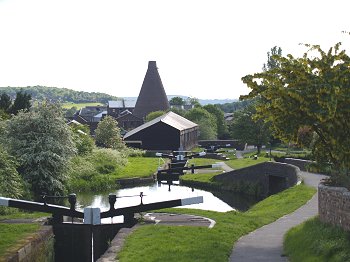 I have always found crystal to be uniquely magical, with its intricate facets breaking light into little shards of the rainbow, but I had little concept of where or how it was made until recently.
I have always found crystal to be uniquely magical, with its intricate facets breaking light into little shards of the rainbow, but I had little concept of where or how it was made until recently.
As far as we can ascertain, crystal owes its origins to man’s desire to imitate nature; in essence, taking cues from naturally occurring rock crystal, mankind developed glass into what we know as crystal today by adding metals to change the character of the glass. Lead was found to produce the best result, helping to create a product that is strong and durable (with a distinct “ring” to it when tapped), but also pleasant to handle, being smooth and warm to the touch. And, perhaps most importantly of all, lead crystal has a brilliant, clear, silvery appearance that responds wonderfully to cutting.
England is one of the great glass-making centres of the world, and the area of crystal is no exception. The tradition began with George Ravenscroft, who established a glasshouse in London in 1673, patenting a process for making “flint glass” (AKA lead crystal) shortly thereafter, upon finding that the addition of lead improved the quality of his glass. He continued experimenting with the exact chemical composition of his “flint glass,” eventually eliminating the initial flaws and exacting the science.
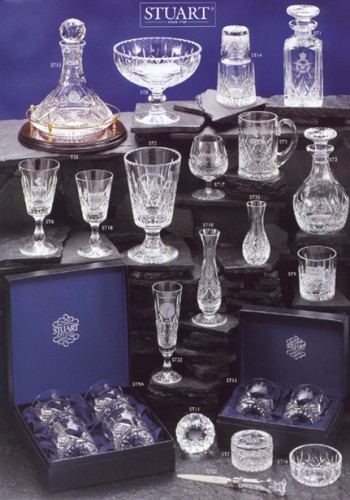 Over time, the majority of crystal glass production in England moved to the Crystal Mile in Stourbridge, part of the Black Country’s industrial heartland, and it is here that Stuart Crystal’s story begins. In 1827, an eleven-year-old orphan by the name of Frederick Stuart was sent to work at the Redhouse Glassworks on the Crystal Mile, carrying on the glassmaking traditions of the generations before him. Young Stuart likely worked in what, to us, might look like something of an alien landscape, with great brick cones towering up to nearly 100 feet high, and coal-burning furnaces raging constantly, filling the air with soot.
Over time, the majority of crystal glass production in England moved to the Crystal Mile in Stourbridge, part of the Black Country’s industrial heartland, and it is here that Stuart Crystal’s story begins. In 1827, an eleven-year-old orphan by the name of Frederick Stuart was sent to work at the Redhouse Glassworks on the Crystal Mile, carrying on the glassmaking traditions of the generations before him. Young Stuart likely worked in what, to us, might look like something of an alien landscape, with great brick cones towering up to nearly 100 feet high, and coal-burning furnaces raging constantly, filling the air with soot.
Stuart, however, appears to have been undaunted by his environment, and by 1853 he, along with Richard Mills, Edward Webb, and Thomas Webb, formed the firm of Mills, Webb, & Stuart. By the time the irascible Stuart retired at the remarkable age of 82, the firm had come to be dominated entirely by him and his sons, making it an entirely Stuart affair. Over the coming generations, these young men carried on the innovating and dominating spirit of their long-lived ancestor, until finally, in 1936, the business outgrew the iconic Red Cone and moved to a factory next to it, thankfully never demolishing the local landmark (it was instead used as storage). Today, it serves as a museum and is the best preserved out of only four such glassmaking cones left in the whole of the UK.
Stuart Crystal can be credited with some truly iconic contributions to the history of crystal, such as Stuart Medallion Cameo Glass (1887) and the Beaconsfield Pattern (1907), which is still used today.
Keeping pace with the times, Stuart Crystal also produced Art Nouveau vases and bowls adorned with trailing green decoration and novelty cocktail sets featuring spiders, devils, and lucky symbols (some of which now reside at the Broadfield House Glass Museum).
The principal designers who helped to shape the look of Stuart Crystal include Ludwig Kny (1918–1937), Reg Pierce (1937–39), and John Luxton (1949–1985), the latter of whom moved the company into the modern era with his contemporary table service designs in the 1950s.
Stuart Crystal is also notable for supplying glass to shipping liners, including the Titanic, and for a remarkable 22,000 items made for Queen Mary in the mid-1930s.
In 1995, the crystal-making firm was successfully bought out by the equally renowned Waterford Wedgwood Company. One would have expected a bright future to develop out of the marriage of these two historic companies, but sadly, in 2001, the Stuart factory was closed forever, making the preservation of those Stuart Crystal pieces that remain a matter of great historical importance.
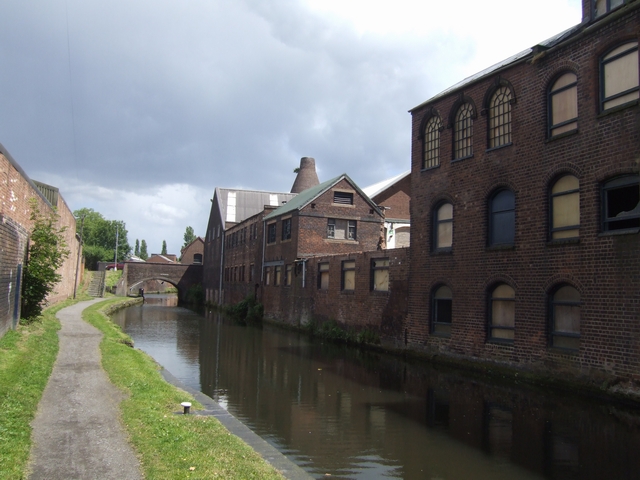
Further Reading:
Glassmakers of Stourbridge and Dudley 1612-2002: A Biographical History of a Once Great Industry – by Jason Ellis – Buy it HERE

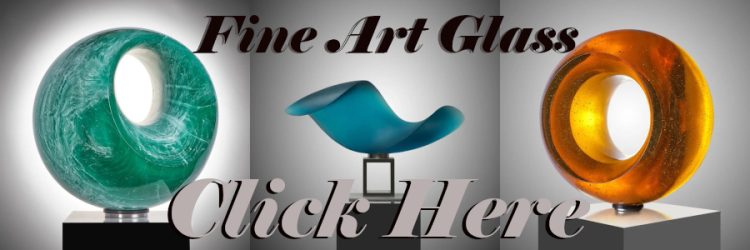
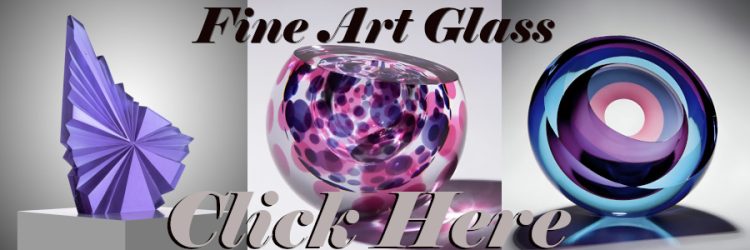
Thank you for this history about Stuart Crystal. Can you please rewrite it or copy and paste it to Wykipaedia? Best Regards.
Hi Michelle,
I don’t have a Wikipedia Account but if you do, and would like to edit the piece and add it to Wikipedia, please mention Boha Glass as the original source. Thanks very much.
Kind regards
Barnaby
Interesting history, so sad that it is no longer in existence.
I was wondering if Stuart crystal ever introduced molded pieces?
Hi Lee
In latter years they produced cut and moulded products, such as lead crystal wine glasses.
Thank you for the information and images of the Stuart plant. I was fortunate to visit it in the 1990s while it still produced. Acquired some wonderful Beaconsfield pattern pieces.
Do you know if Stuart produce their crystal without the STUART signature … perhaps “in the early days”. We see examples today offered without the signature and some have said that the lack of signature reflects that the piece is a “factory second”. Others have said that STUART did not sign their crystal at the beginning of their life.
Can you help?
thank you.
As far as I am aware, you are correct in that ‘firsts’ have the Stuart etched on the piece, while flawed, or factory seconds, do not. The flaw may be tiny (and sometimes you have to really look) to see why the piece is classed as a second. The cone nowadays operates only as a museum.
Hi Mike , I was a glass cutter at Stuart’s from 1973 to 2001 and imediately noticed your familiar sir name , too much of a coincidence I think (?) ..
At the end of the Stourbridge factory and after some production was in eastern Europe and they tended to “over polish” which sometimes made it look molded
In charity shops of Stourbridge you can often get crystal for a fraction of it’s original value ,, sad end
I bought two wine glasses at a Stuart showroom on the north coast of Scotland in the early 2000s. I can find no marking. Where would it be?
Hi Mary. We can’t help you with that I’m afraid. Boha Glass is an online shop selling new, contemporary art glass and home decor. Thanks!
Hi Mary. I just googled it and it shows the word Stuart on the outer rim of the foot (base of the wine glass). Just don’t look for it when the glass is full of good claret!
Please note we do not offer valuation / identification information as we are an art glass shop and gallery. Thanks!
I came across a Stewart Shaftesbury fruit bowl recently which was etched with the Stuart logo but was clearly a moulded piece. It looked absolutely awful. This is why I am researching here as I could not understand it.
Hi Adele. What a shame! Why not buy some art glass from us instead. You are guaranteed original art by some of the world’s most talented artists!
Hi I worked at Stuart’s for 27 years I was a master cutter the bowl you came across was probably a machine cut bowl from mid 90s
Or one of the hideous imported garbage from Poland so sad it was embarrassing at the time and unfortunately was the companies demise in my opinion miss my job although it’s been some 24 years ago
Hi I have a pair of Stuart decanters that I have been unable to identify and age. Is this something you would do please?
Hi Nicola. I am afraid not. We do not provide that service. We are purely an art glass and home decor shop. Thanks!
I’m downsizing and if you know of someone who might be interested let me know. Lovely pieces. I was told by Harrods staff the gold work was done in Wales. It’s the Victoria Clear pattern
I was fortunate to work for Stuart Crystal for 5 years as a store manager , and can confirm that seconds have no back stamp . Most seconds contain a slight flaw , a grain of sand, an air bubble , none of which deter from the beauty of the piece .
Hi
I was given a set of whisky tumblers from the Stuart range back in 1997 – I can’t did. The range name and have looked on various sites but no pattern is matching up. Do you have any ideas where I may find a complete range to look through online please? Thanks
Thank you for the history. I just recently acquired several Stuart pieces from the “Ariel” collection at an estate sale. Do you know the history of this series?
Hi Herman
No, we are not aware of the history of that series. If you have any information about the ‘Ariel’ series, we would be delighted to publish it here. Thank you
This might be a stupid question, but if Stuart Crystal is no longer a working company how is it the Stuart Crystal Items are being sold still I have bought a Stuart Crystal Shelton bowl made in Germany. I found the history on the company you provided very interesting. Thank you.
Hayley
Hi Hayley
The Stuart Crystal brand is now owned by the Waterford Group. I know Stourbridge have re-opened the Stuart Crystal factory, so it is still possible to buy some Stuart Crystal pieces but unsure where they are made.
I HAVE BOUGHT LOTS OF STUART CRYSTAL. CHAMPAGNE FLUTES FOR MY SON AND DAUGHTER-IN-LAWS WEDDING AND WINE GOBLETS IN THE FUSHIA DESIGN. I WANTED TO REPLACE A COUPLE OF CHAMPAGNE FLUTES BUT ALAS THE CRIEFF FACTORY IS NO MORE. I WOULD ALSO LIKE TO PURCHASE A COUPLE OF WINE GOBLETS (JUST IN CASE I BREAK A COUPLE )
I WAS MOST DISAPPOINTED THAT STUART WAS BOUGHT OUT. YET ANOTHER SKILL LOST IN PERTHSHIRE.
Hi Jean
Thanks for commenting! Yes, it is a real shame that craftsmanship like this is disappearing. It will soon be a lost art if we do not support and preserve it.
I have replaced Thos Webb crystal glasses…Some original, some repro. You might get Stuart Crystal there.
I have a Stuart Crystal City of Chester chalice with supporting COA and the receipt from when it was purchased. Limited issue 100. I have seen the goblets on eBay but not the chalice. Do I have the only one still in existence???
We have the discontinued Stuart Crystal STU1-1 pattern.
We purchased it in England in the 1970’s, I believe.
Why does it not have a name and what year was it made?
Thank you for your help.
I am looking for a Stuart crystal whisky glass which is stamped with Oban 1794. How many were made, and this one is around 1940s and 50s.
dose any one know of any pension scheme stuart crystal & son wordsley had over the past years ????????
It’s a bit of a local bugbear but Stuart Crystal glassworks and the remaining cone are in Wordsley not Stourbridge.
Glass manufacturing was based in Brierley Hill,Wordsley and Amblecote not Stourbridge.
Brierley Hill and Wordsley were even in a different county..Staffordshire.
It may be pedantic but local history is just that..local.
Driving past the “Stourbridge Glass Museum” nearly every day of my life to and from Wordsley makes me want to get up a ladder with a paint brush
Hi Stuart, I absolutely agree with your comment. It makes my blood boil when the so called experts call it Stourbridge glass. There was virtually no glass made in Stourbridge, while Wordsley was home to Stuart, Tudor, Bolton and Mills, Richardson, Edward Webb etc. Stevens and Williams, later Royal Brierley, was in Brierley Hill. All of these were in Staffordshire, not Worcestershire. The only glass from there was several companies in Dudley (about 7) the most famous of which was Abiatha Hawkes, later Thomas Hawkes, who made a suite of glass for Queen Victoria’s banquet, and of course Thomas Webb and Webb Corbett. I think it’s about time the experts put the record straight and give Wordsley the credit it deserves. I see many pieces of Stuart glass labelled as Powell or S & W, it’s about time this was put right as well.
Let me know if you need someone to hold your ladder!
Hi Stuart,
I worked at Stuart Crystal for many many years, it was a great place to work. I know what you are saying I feel exactly the same. Stourbridge Glass Museum no way as far as I am concerned it will always belong to Wordsley. Fortunately for me I don’t go past the place very often now I am very glad to say as what they have done to the place is disgusting, especially the borough council selling the place off to a private company.
I have a Stuart crystal glasses from my grandparents – would love to know more about them if that is possible.? Can send photos?
Hi Ruth
We can put the photo up here and people might be able to help you.
Thanks!
Hi I worked at Stuart’s for 27 years if you want to email them I might be able to help
No mention in your write up about the factory Stuart Crystal opened in 1966 in South Wales, it was called the Pengam factory and was actually in the mining village of Aberbargoed starting with just 6 cutting apprenticeships, under the tutelage of Mr Furness who moved from Stourbridge to train the them.
The site grew taking on more apprentices and added a glasshouse for glassblower apprentices.
at one time employing over 120 youngsters. so Stuart’s had bases in 3 of the UK countries.
When the the Company was sold to Waterford it soon saw the demise of Stuart’s in Wales and Pengam Glassworks was closed on 2nd May 1997.
I have 2 footed crystal glass bowl the other one is abit smaller and in square with same star looking decor on the bottom with very small bubbles and no markings, I wonder if it was his work?